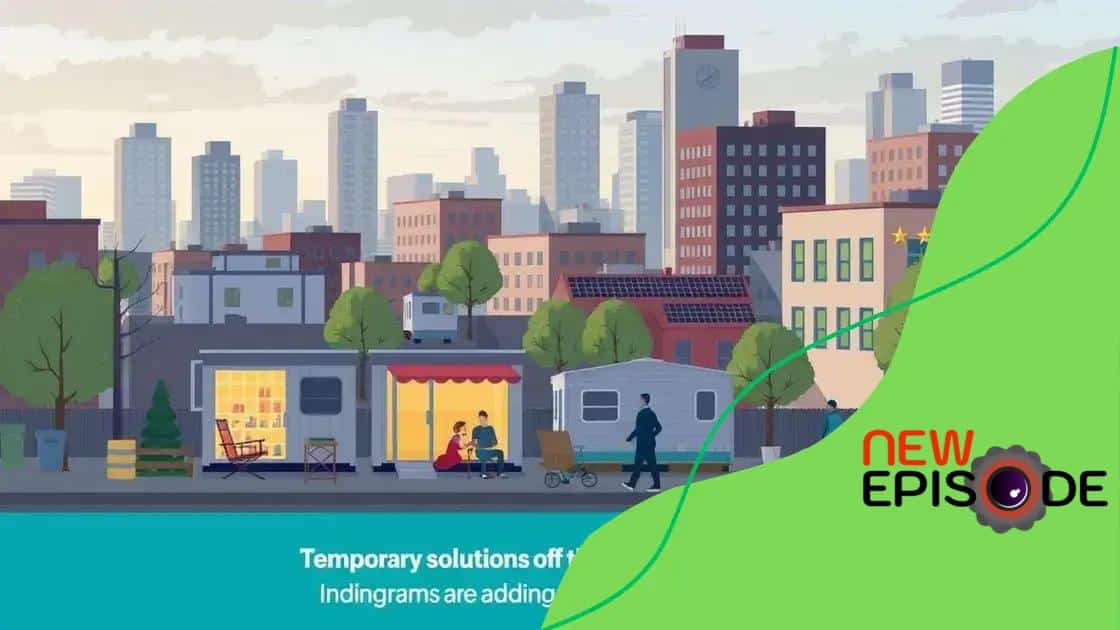How federal funding is addressing the homeless crisis

Federal funding is vital in addressing the homeless crisis, focusing on prevention, immediate shelter, and supportive services while navigating challenges such as resource allocation and community engagement.
How federal funding is addressing the homeless crisis is a pressing issue today. Communities are seeking new solutions to support those facing housing instability. Are current efforts effective enough, or is there more to be done?
Understanding the current homeless crisis
Understanding the current homeless crisis requires a closer look at its roots and effects on communities. Rising housing costs, unemployment rates, and mental health issues contribute significantly to this challenge. Many people find themselves navigating these tough circumstances without adequate support.
Factors Contributing to Homelessness
Several underlying issues drive the homeless crisis today. It’s essential to examine them one by one:
- Affordable housing shortages: As rents increase, affordable options decrease, pushing more people out of stable living conditions.
- Economic instability: Job loss and underemployment leave families struggling to make ends meet, leading to eviction.
- Mental health and addiction services: A lack of accessible services makes it difficult for individuals to seek help.
- Systemic barriers: Discrimination and a lack of resources often hinder families and individuals from accessing necessary support.
The impact of homelessness is profound. Individuals face not only physical challenges but also social stigma. Children experiencing homelessness often struggle in school, affecting their long-term opportunities. Communities must work together to raise awareness and promote effective solutions.
Community Responses to the Crisis
Local governments and nonprofits are implementing various programs to address the crisis. These initiatives aim to provide immediate assistance as well as long-term solutions. Many organizations focus on:
- Emergency shelters: Offering safe spaces for individuals and families in need.
- Transitional housing: Helping individuals move toward stability through supportive services.
- Job training programs: Equipping people with skills to secure better employment.
- Health services: Addressing mental health and addiction issues to help individuals recover and regain independence.
By understanding the factors that contribute to the homeless crisis and the responses initiated by communities, we can better support those affected. Each step taken represents hope and a chance for lasting change.
Federal funding programs in action
Federal funding programs are crucial in addressing the challenges faced by the homeless community. These initiatives aim to provide immediate support while also working toward long-term solutions. By understanding how these programs operate, we can see their impact on local communities.
Types of Federal Funding Programs
Several federal programs offer assistance specifically aimed at reducing homelessness:
- HUD-VASH: This program combines Housing Choice Vouchers with supportive services for veterans.
- Continuum of Care (CoC) Program: Aims to promote community-wide commitment to the goal of ending homelessness.
- Emergency Solutions Grant (ESG): Provides funding for emergency shelter and homelessness prevention.
- Supportive Housing Program: Focuses on helping individuals secure permanent housing and achieve self-sufficiency.
Each of these programs plays a distinct role in the fight against homelessness. By providing funding for housing, health services, and social support, communities can create comprehensive strategies to help those in need. The integration of these services ensures that support is not just temporary but paves the way for lasting change.
Successful Implementation Examples
Various cities have effectively utilized federal funding to combat homelessness. For instance, in Los Angeles, the Homeless Outreach Program allocates funds to local organizations that offer housing assistance and mental health services. Similarly, New York City has launched initiatives that focus on rapid rehousing, aiming to get individuals into stable living situations quickly.
As these cities demonstrate, collaboration between federal programs and local organizations is essential for success. By sharing resources and expertise, they can address the root causes of homelessness while meeting immediate needs.
Success stories from funded initiatives

Success stories from funded initiatives provide real-life examples of how federal funding can effectively address homelessness. These stories not only inspire hope but also demonstrate the positive impacts of community efforts. Learning from these successes is key to shaping future programs.
Transformative Programs
Several initiatives have made significant strides in reducing homelessness through creative solutions and collaboration:
- Pathways to Housing: This program focuses on providing housing first, followed by support services. It has helped many individuals regain stability.
- Rapid Re-Housing: This initiative offers temporary financial assistance to help families and individuals find permanent housing quickly. The success rate has been impressive, lowering homelessness in various regions.
- Los Angeles Project Roomkey: Launched during the pandemic, this program utilized vacant hotels and motels to shelter those without homes, showcasing adaptability and immediate impact.
- The Homeless Outreach Program: This program in Denver connects homeless individuals with housing, healthcare, and employment services, demonstrating the importance of a holistic approach.
These programs illustrate the potential of federal funding to drive significant change. By implementing strategies that prioritize immediate housing and support, organizations can empower individuals to reclaim their lives.
Community Involvement
Community involvement plays a crucial role in the success of these initiatives. Many local organizations partner with federal programs to maximize resources and reach more people. Volunteers often engage directly with those experiencing homelessness, helping to build trust and connection.
Partnerships with businesses also enhance these efforts. For example, a collaboration between local shelters and job training programs allows individuals to gain skills and employment opportunities. This multifaceted approach ensures that people are not only housed but also supported in their journey to self-sufficiency.
Challenges in deploying federal resources
Deploying federal resources to combat homelessness presents various challenges that can hinder the effectiveness of these initiatives. Identifying these obstacles is crucial for creating solutions that work for communities in need.
Resource Allocation Issues
One major challenge is the proper allocation of resources. Funds often come with restrictions that limit their use. This can make it difficult for local organizations to tailor solutions to their community’s unique needs. For example, a program designed for urban areas may not be suitable for rural communities.
Additionally, the amount of funding can fluctuate yearly, leading to uncertainty for organizations that rely on this support. Such unpredictability creates difficulties in planning long-term support services.
Coordination Among Agencies
Effective communication and coordination among various agencies also pose a challenge. When multiple organizations are involved, it can become complex to manage roles and responsibilities. Miscommunication often leads to duplicated efforts or critical gaps in service. Collaboration is key to a successful response, yet barriers can exist, such as differing priorities and agendas.
Moreover, challenges in sharing data between agencies can further complicate matters. Without accurate data, it’s tough to assess the effectiveness of programs or identify areas needing improvement.
Public Perception and Political Climate
Public perception and the political climate can also affect the deployment of federal resources. Community support is necessary to implement initiatives successfully. However, negative attitudes toward homelessness can create obstacles to engagement and funding. Political decisions and changes in leadership further influence the direction of funding and policy.
Addressing these challenges requires a collaborative effort. By fostering partnerships between federal, state, and local organizations, we can work towards overcoming these obstacles and effectively deploying resources for those in need.
Future of federal funding and homelessness
The future of federal funding and homelessness is a topic of great importance, as it shapes the strategies communities will use to address this ongoing issue. As awareness grows, new funding initiatives are being developed to create lasting solutions.
Emerging Funding Strategies
One promising trend is the shift towards preventive measures. Funding is increasingly directed toward programs that aim to stop homelessness before it starts. These initiatives focus on:
- Rental assistance: Helping families stay in their homes through financial support.
- Mental health services: Providing early intervention to those at risk.
- Job training programs: Equipping individuals with skills to secure employment and stability.
These strategies reflect a holistic approach to tackling homelessness by addressing the root causes instead of merely responding to crises.
The Role of Technology
Technology will also play a vital role in the future of federal funding. Data-driven decisions can lead to more effective allocation of resources. For example, using data analytics helps identify areas with the highest need, ensuring that funds are directed where they can have the most impact.
Moreover, online platforms can improve communication between agencies, enabling real-time sharing of information on available services and resources. As technology advances, the aim is to create a more integrated and responsive system that can adapt to changing needs.
Collaboration and Community Engagement
The future also emphasizes the importance of collaboration between federal, state, and local levels. Strong partnerships enhance the effectiveness of programs and help unify efforts across different agencies. Engaging communities in the decision-making process fosters ownership and accountability, ensuring that the resources meet specific local needs.
By encouraging community involvement, the focus can shift toward innovative solutions that are tailored to each area’s unique challenges. This collaborative approach can ultimately lead to a more sustainable fight against homelessness.
FAQ – Frequently Asked Questions about Federal Funding and Homelessness
What are the main goals of federal funding for homelessness?
The main goals include preventing homelessness, providing immediate shelter, and offering supportive services to help individuals regain stability.
How does data influence funding decisions for homelessness programs?
Data is used to identify areas of greatest need, measure program effectiveness, and ensure that resources are allocated efficiently.
Why is community involvement important in addressing homelessness?
Community involvement helps tailor solutions to local needs, builds trust, and ensures that efforts are sustainable and relevant.
What challenges do federal programs face in addressing homelessness?
Challenges include resource allocation issues, coordination among agencies, and fluctuating public support, which can impact funding and program effectiveness.






